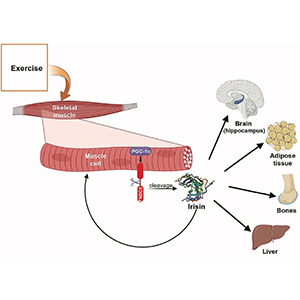Salivary and serum irisin in healthy adults before and after exercise

Accepted: 11 January 2023
HTML: 59
All claims expressed in this article are solely those of the authors and do not necessarily represent those of their affiliated organizations, or those of the publisher, the editors and the reviewers. Any product that may be evaluated in this article or claim that may be made by its manufacturer is not guaranteed or endorsed by the publisher.
Authors
Irisin is an exercise-induced cytokine mainly secreted by myocytes. Circulating level of irisin can increase in response to acute exercise, promoting pleiotropic effects on health. Generally, irisin is evaluated in blood, however, its collection is invasive. Saliva sample would not have any risk associated with blood collection and would represent a less invasive method for irisin detection. Until now, there are only a few studies that have analyzed irisin levels in saliva. In the present research, five healthy male adults performed an incremental exercise until exhaustion on cycle ergometer. Serum and saliva samples were collected before exercise and 15min, 24h and 48h after reaching the exhaustion. Irisin was detected by ELISA assay. Serum and salivary irisin levels increased from baseline to 24h post exercise and reverted to basal levels after 48h of rest. A significant rise of both serum and salivary irisin level at 24h (p≤0.05) compared to baseline levels was found. Furthermore, a significant correlation between irisin percentage change in serum and saliva from baseline to 24h post exercise was detected (r=0.92, p<0.05). Despite the relatively limited sample, this research suggests that collecting saliva samples might represent a valid and less invasive method to detect irisin level changes induced by exercise.
How to Cite

This work is licensed under a Creative Commons Attribution-NonCommercial 4.0 International License.
PAGEPress has chosen to apply the Creative Commons Attribution NonCommercial 4.0 International License (CC BY-NC 4.0) to all manuscripts to be published.
Similar Articles
- Sabrina Conejeros-Lillo, Francisco Aguirre, Daniel Cabrera, Felipe Simon, Luis Peñailillo, Claudio Cabello-Verrugio, Role of the ubiquitin-proteasome system in the sarcopenic-like phenotype induced by CCL5/RANTES , European Journal of Translational Myology: Vol. 34 No. 1 (2024)
You may also start an advanced similarity search for this article.

 https://doi.org/10.4081/ejtm.2023.11093
https://doi.org/10.4081/ejtm.2023.11093



